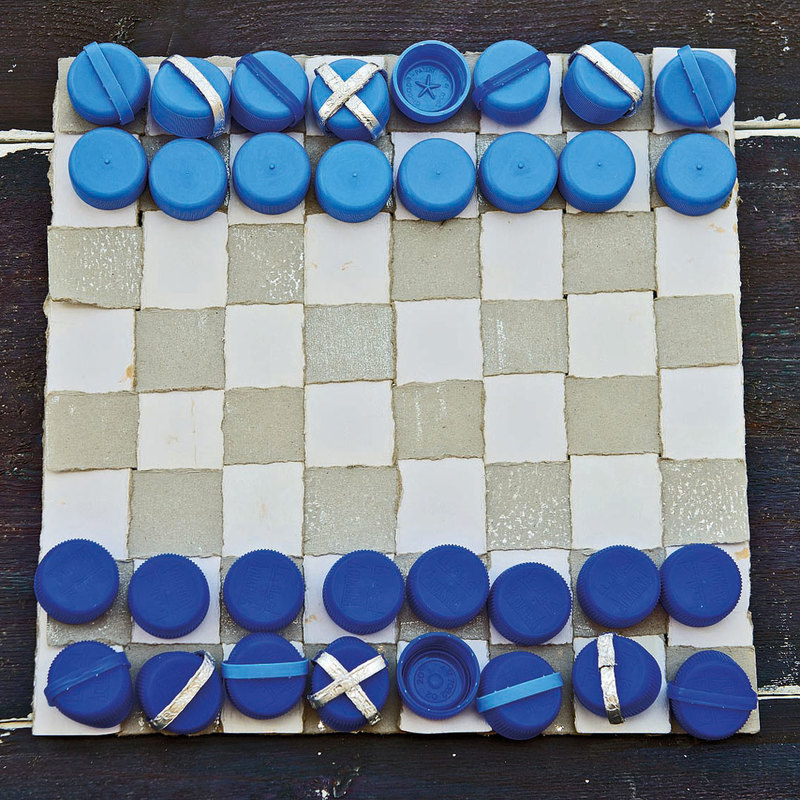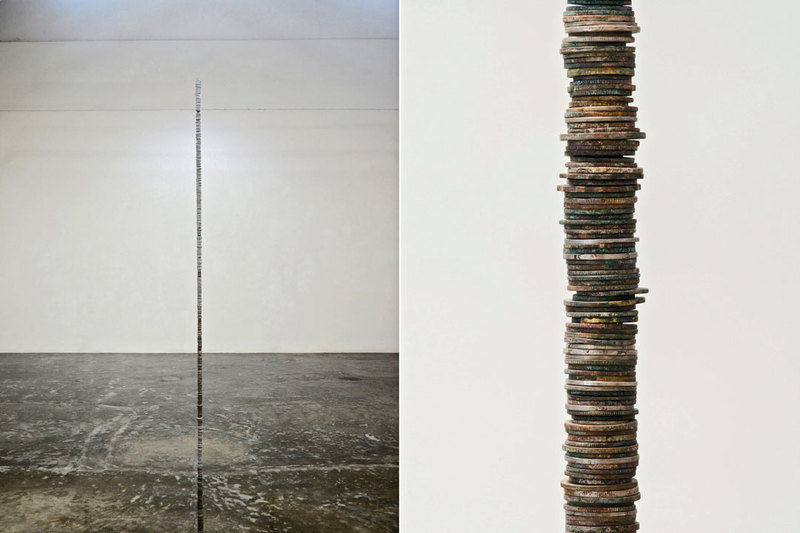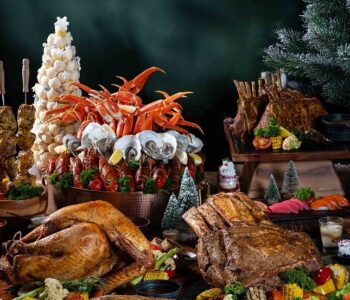
Whereas in the past the Friends of Jakarta Museums Foundation (Yayasan Mitra Museum Jakarta/YMMJ) has presented historical exhibitions, this time it attempts to make history by presenting, in collaboration with the Bali-based Kayu | Lucie Fontaine, a contemporary art exhibition showcasing works by artists from Indonesia and abroad, including Arahmaiani, Ashley Bickerton, Chris Bunjamin, Marco Cassani, Rafram Chaddad, Cian Dayritt, Fendry Ekel, J. W. Heydt, Agnieszka Kurant, Goshka Macuga, Michelangelo Pistoletto, Sindoedarsono Soedjojono, and Rirkrit Tiravanija, entitled We Move Amongst Ghosts | Justice. The main part of the exhibition title, is taken from an essay “We Move Amongst Ghosts” by British artist Laura Grace Ford, which introduces her book, Savage Messiah (Verso Books, 2019). Part graphic novel, part artwork , the book is both an angry polemic against the marginalization of the urban working class and an exploration of the cracks that open up within an urban context.
Exhibition coordinator Adi Hong-Tan explained, “We chose this title because in Jakarta, like in Ford’s London, sites and spaces have an ability to shape our emotional, cultural and intellectual infrastructure; and that this infrastructure can outlive those sites and spaces and evolve, acquiring new meanings through interaction with new spaces and objects. The past lives on as ghosts who inhabit our mental universe.”
The show aims to look at the interface between object and space on the one hand, and memory on the other. In particular, it focuses on how object and space can conjure up historical and communal memory. This underlying idea harks back to Kayu’s fifth project in 2016, “Ritiro”, in which a group of artworks ‘went’ on a retreat from Bali to Java, thus suggesting the idea that space and object, things without life in themselves, might have a kind of existence —an internal life—of their own. “We Move Amongst Ghosts | Justice” builds on this suggestion in relation to the definition and meaning of a museum, particularly its role as a nexus between the past and the present.

Kayu | Lucie Fontaine in collaboration with YMMJ carefully and deliberately selected the venue for the exhibition. In 2018, YMMJ commissioned the Indonesian artist Chris Bunjamin to document seven of the eleven museums belonging to the Special Capital Region of Jakarta, all of them eminent landmarks in the Indonesian capital and in the Indonesian national consciousness, including the National Monument (Monas), the Jakarta History Museum, the Museum of Fine Arts and Ceramics, the Textile Museum, the Wayang Museum, the Museum Prasasti and Gedong Joang ’45. Bunjamin produced a series of seven black and white photographs of these buildings, conveying a personal impression of Jakarta’s collective memory. One of the documented sites in particular, the Museum of Fine Arts and Ceramics, is considered as the most appropriate venue for the exhibition, as it would bring the artworks on show into a dialogue with the museum’s past, its permanent collection and its urban context, Kota Tua (Jakarta’s historically-charged ‘Old Town’). The show would recall the museum’s earlier role as the Raad van Justitie, which served as the highest court of justice in colonial Indonesia. A mental space – with “Justice” as its theme – would be created in the façade, portico and main hall of the museum, within which the artworks are displayed. The overall effect is a play on the building’s former function as a judicial seat, but one now in which artworks would present themselves before the court of public of opinion. It is an invitation to explore the memories conjured up by both space and object, memories that form the linkages between our past and present.
Indeed, the Jakarta Museum of Fine Art and Ceramics (Museum Seni Rupa dan Keramik Jakarta) has great historical significance. Acting on the instruction of King Willem III of the Netherlands, Pieter Mijer, the 19th Governor-General of the Netherlands East Indies (now Indonesia) commissioned Baron Willem Herman Frederik Hendrik van Raders in 1866 to design a new building to house the Raad van Justitie, the highest court of justice in the colony. Completed in 1870 at a cost of 269,000 gulden, the building was called the Paleis van Justitie. The building underwent numerous changes of function during the Japanese occupation (1942 – 1945), the Indonesian Revolution (1945 – 1949) and the early decades of Independence. On August 20, 1976, on the recommendation of Vice-President Adam Malik, General Soeharto, the 2nd President of Indonesia inaugurated the building as Balai Seni Rupa (the ‘Gallery of Fine Arts’). On June 10, 1977, a section of the building was designated as Museum Keramik (the ‘Ceramics Museum’). In 1990, both institutions were joined together as Museum Seni Rupa dan Keramik (the ‘Museum of Fine Arts and Ceramics’). It was deemed most appropriate for the exhibition venue.
A great variety of works will be presented in the exhibition. Agnieszka Kurant’s The End of Signature is a neon light installation that was commissioned and exhibited on the facade of Guggenheim Museum in New York in 2015. The artist collected more than 40.000 signatures from visitors of Guggenheim Museum and input them using an algorithm which synthesized the 40,000 signatures into a new signature.
Michelangelo Pistoletto’s artwork consists of a large mirrored table (7 x 4 meters), designed specifically for the group exhibition “The Great Archipelago” at Kayu in December 2018 and twelve chairs. The idea is that during the exhibition period, Pistoletto’s artwork will host ten/twenty people to discuss and share the activities of the guests carried out on the territory (Indonesia), on ten themes inspired by the objectives of the Sustainable Development Goals (SDGs).

Prison Chess may be the only ‘genuine’ Arte Povera piece Rafram Chaddad made. “I worked on this chess board for two months, seated on the floor of the notorious Abu Salim prison in Tripoli. It was done out of boredom. I did it for my eyes only, not thinking of my time with Michelangelo Pistoletto at Cittadellarte – Fondazione Pistoletto, or about random art concepts. Slowly I waited for more bottles and more food boxes, slowly separating the aluminium layer from the cardboard. When I tried to look at myself in the dimmed reflection, maybe then I thought about the mirror works of Pistoletto. Then I played chess against myself, few times a day. I hate this game, but I did it to survive mentally. I kept losing to myself. Ten years later and Kayu Lucie Fontaine asked me to have this piece to be presented in an exhibition in Jakarta and since I forgot where I left the old one, made with blood and tears, I made a new one, much faster, but used the same techniques by hand, this time with music, light and the sea in front of me”, the artist explained.
Rafram was born in Djerba, Tunisia, and made aliya to Israel with his parents while a small baby. He grew up in Jerusalem where he also finish his photography studies. Establishing himself as an artist since 2004, Rafram has been living and creating in various countries in Europe, as well as Israel and Tunisia. In recent years his works were exhibited in several museums and galleries across the world (including the Herzliya Museum, the Tel Aviv Museum, the CAMeC Museum, ACC Galerie, and more). Rafram’s works are infused with biographical elements and Jewish themes. For the past ten years Rafram has also engaged with the idea of food as culture, teaching a course on food at the Bezalel Academy of Art in Jerusalem and formerly head of the Slow Food movement in Israel. Recently, Rafram has returned to Tunis, where he continues to pursue his art and has also established, together with his uncle, a company that brings traditional Jewish recipes to life. Habiba, the company, is named after a famous Jewish Tunisian singer, Habiba Mesika, and after Rafram’s mother. Rafram is also author of a book on his incarceration in a Libyan prison, arrested while in Libya to document the remnants of the Libyan Jewish community.

In God We Trust, is a collaborative work between Fendry Ekel and Marco Cassani. It….. uses one of Fendry Ekel’s gates, a series he personally started in 2017. In this gate series Fendry Ekel is among other things dealing with the concept of stand-alone spaces in between as a place for abstract encounters and as a harbour of ideas. In God We Trust is a famous phrase that is often used in many occasions in all over the world, especially in the United States; it is written on the walls of courtrooms, printed on bank notes, engraved on the side of coins etc. Known for his signature use of unique metal, Marco Cassani was invited to do a kind of “intervention” to make the title of the work made of of melted metal coins that Cassani found in many sacred springs in Bali, thrown by visitors and believers to accompany their personal secret wish. This unique collaboration developed as an artistic dialog between both artists started already in early 2019 when Ekel gave Cassani as a suggestion to use the phrase “In God We Trust” for the title of his work in progress, which were a pair of wedding rings he created as a gift for his best friends’ wedding. The piece can be considered as manifestation of Fendry Ekel’s and Marco Cassani’s visions that move parallel regarding their understanding about the concept of power and belief and the transformation of it into value.
It is known that the Indonesian movie industry is predominated by horror movies. Filmmakers know that if they want to get big audience numbers, their best bet would be to make a horror movie. Even television shows that feature scary old buildings as places where one can find ghosts get good ratings. Although We Move Amongst Ghosts has nothing to do with horror in art, but perhaps the horror loving Indonesian audience might find this exhibition a fascinating show to visit, and in turn learn to appreciate art!
Conceived by Tel Aviv-based curator, editor, writer and educator Nicola Trezzi, together with Los Angeles-based artist Alice Tomaselli, Lucie Fontaine is an imaginary “employer”, in many ways also a “ghost”. Trezzi and Tomaselli call themselves “employees” of Lucie Fontaine; later on, New York-based writer, curator and studio manager Elena Tavecchia joined the staff, together with artist Marco Cassani, Lucie Fontaine’s employee in Bali. Since its establishment, Lucie Fontaine has invited several artists, mostly Italians, to exhibit in her spaces in Milan, Stockholm, Tokyo and Bali. She has also been invited to group exhibitions, festivals and events in various institutions. Perhaps we need ghosts to inspire us and to get us working. Let us move amongst ghosts!







